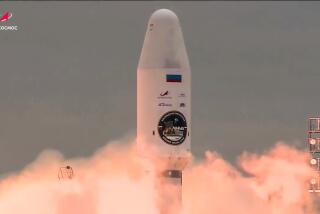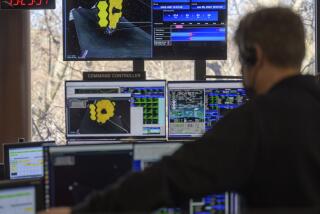Russia Mirror in Space May Lead to Lighted Cities
- Share via
MOSCOW — Russian space scientists began an experiment to launch a giant mirror from the orbiting station Mir early today in pursuit of the futuristic idea of lighting up northern cities at night with the reflected rays of the sun.
The shiny disc, 25 yards across, could also be considered a precursor to a solar sail--a means of propelling a solar-powered spacecraft that scientists have long dreamed of creating and sending to the moon, according to officials at the Flight Control Center near Moscow.
“It’s very fantastic,” deputy flight director Viktor Blagov said. But “as the Russian saying goes, he who doesn’t risk never gets to drink champagne.”
The experiment began before dawn today in Moscow--early Wednesday evening in the Pacific time zone. But it was not carried on live television, and little information on its results was expected before this morning.
If the mirror functions correctly, said Blagov before the launch, the sun’s rays reflecting off it would shine a shaft of light several miles wide onto the nighttime side of the planet.
Moving with the Earth’s rotation, the column of light would race at about 5 miles a second across Europe from Lyon in France to Brest in Belarus until it fades in the sunrise over Russia.
To the people in its path, however, it would be visible only as a sparkle in the sky beginning from about 7 p.m. PST, scientists said.
“If everything works,” Blagov said, “and we learn to control such discs and get the financing and put a lot of discs into orbit, we can offer services like, say, the lighting of Alaska.”
Or, at least, the discs could light up key industrial areas in spots such as the mining city of Vorkuta in Russia’s Far North, where the polar night hampers operations for four months a year, Blagov said. It could also be used to light rescue operations and earthquake zones when all power is lost.
Russia’s space program, once a showpiece of Soviet technology that jarred America by launching the first Sputnik in 1957, has faltered as the strapped government has cut back its funding.
But it has also made impressive strides in turning space into a paying proposition. For instance, it markets its satellite-launching rockets at a fraction of what its U.S. rivals charge for a launch.
And Russia now holds a clear advantage in the arcane race to create a solar sail, leading French, American and Japanese rivals. With Operation Banner, as the launching of the mirror has been dubbed, Russia would become the first country to test-fly something close to a solar sail.
Made of light, strong material known as Mylar and covered with a super-thin layer of shiny aluminum, the mirror--which also could serve as a sail--weighs less than 100 pounds in all.
Space engineer Nikolai Kryuchkov said the mirror cannot be considered a full solar sail, however, because it would be towed by a supply ship, the Progress, rather than powered by solar particles bouncing off its reflective surface.
The idea behind the solar sail is that if a craft is light enough, it can be propelled through space faster and faster by solar particles called photons, which impart a tiny bit of energy whenever they strike a solid object.
Western scientists speculate that such solar sails could provide the basis for interplanetary travel.
Blagov said that it would take from 30 to 60 days for a solar sail to build up any speed, but that once it got going, its energy would be basically free, like wind for a sailboat.
He estimated that it will take at least three or four years to build a full-fledged sun craft, which Russian scientists have said could have a sail 200 yards in diameter and reach the moon in several months.
The Mir station’s supply ship, Progress, will launch the large mirror, which is to slowly unfurl in eight sections over the course of several hours.
Progress was also slated to carry out another unprecedented experiment, the launching of what is known as a “free flier,” a small craft that would float near the giant, permanently orbiting Mir station.
It would be used for scientific experiments and the growing of crystals, which requires an environment purer than the cosmonaut-inhabited Mir can provide.
Blagov said that although the free flier has been widely discussed in the West, “This is the first time it has been tried in the history of space experimentation.”
More to Read
Sign up for Essential California
The most important California stories and recommendations in your inbox every morning.
You may occasionally receive promotional content from the Los Angeles Times.













